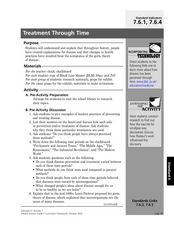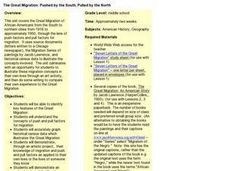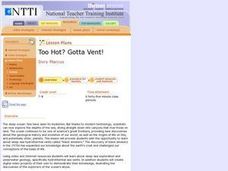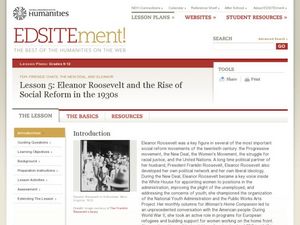Curated OER
Magnificent Microscopes
Students use a microscope in a series of activities that are designed to help them explore the "invisible world" and make meaningful microscopic discoveries and learn the importance of the microscope as a tool in science and research.
Curated OER
A Day in the Life
Students inquire about the politics and culture of Ancient Rome. In this Ancient Rome project/unit, students research life during ancient Roman times and create a newspaper with articles on politics, sports, culture, and economics.
Curated OER
Starquest
Students study the history and cultural interpretation of a celestial body or constellation. They create technology based presentations of the information.
Curated OER
The Last Great Race
Third graders identify and discover why the Iditarod race is done each year. They explore the historical significance of the Iditarod. Students also use web sites to research related topics, i.e. diseases (diptheria), geography of...
Curated OER
Kids Build Pumpkin-Tossing Catapult
Students read a news article about the creation of a catapult that will throw pumpkins. In this current events lesson plan, the teacher introduces the article with a discussion of catapults and a vocabulary activity, then students read...
Curated OER
The Impact of the IWW on the Nation or Who were the Wobblies?
Learners evaluate the role labor groups had on the U.S. Government in the early 1900's. In this teaching American history lesson, students complete several activities, including response writing and listening to music, that...
Curated OER
We Are The Freedom Riders
Students consider the role of the Freedom Riders. In this American Civil Rights lesson, students watch videos, listen to lectures, and conduct research regarding the participants in the Freedom Ride protest. Several weblinks, worksheets,...
Curated OER
Treatment Through Time
Seventh graders explore how disease prevention and treatment changed throughout history. In this life science lesson, 7th graders create a classroom exhibit about this topic. They present their project to visitors.
Curated OER
The Great Migration: Pushed By The South, Pulled By The North
Students identify key features of the Great Migration. They explain the concepts of push and pull factors for migration. They create an art project which shows an understanding of the push and pull factors.
Curated OER
Too Hot? Gotta Vent!
Learners study deep sea exploration and underwater geology, specifically hydrothermal sea vents. They create digital video projects of their own to demonstrate their knowledge, illustrating the discoveries of the explorers of the ocean's...
Curated OER
Paper Plate Observation
Students analyze transits from previous scientists. They identify simple objects that could have been used for documentation in the science world. They also practice scientific inquiry using methodology.
Curated OER
ELEANOR ROOSEVELT, OLIVIA'S FRIEND
Students study Eleanor Roosevelt the person. They explore how she cared about people. They examine what she looked like and some basic good qualities about her.
They study three historical facts about ER, such as: Eleanor Roosevelt...
Curated OER
A Century of Challenge and Change: The Filipino American Story
Students recognize the events that led to the Philippine Revolution. In this Philippine Revolution lesson, students relate the causes of the Philippine Revolution to situation in the world today. Students examine the Philippine Equation...
Curated OER
Shoot for the Moon
Second graders distinguish the different phases of the moon. In this astronomy lesson, 2nd graders study the history of its discovery and myths about its origin. They simulate how the moon's surface is illuminated by the sun.
Curated OER
Impact of Ancient Rome on Life Today
Middle schoolers research the importance of ancient Rome to the world today. In this ancient Rome lesson, students view video and research to gather information for a slide show about Ancient Rome.
Curated OER
Animal Farm
An exploration of "Animal Farm" can be a way to get students thinking about politics, history, and literature.
Curated OER
Soldados: Soldiers' Stories
This lesson will help students practice conducting an oral history interview, increase knowledge about what it is like to be a soldier, gain knowledge about the Vietnam War and gain knowledge about the Chicano experience in the U.S.
Curated OER
Cells: Structures and Processes
Students explore the basic unit of life, the cell in this nine lessons unit. The cell structure of animal and plant cell functions and how they affect our world are probed in this unit.
Curated OER
Nature in a Flick of the Eye
Students explore the visual information a diorama artist provides by thinking of all the details for the background of a location described by their teacher. They investigate diorama artists and their importance in creating the illusion...
Curated OER
A Look Through My Antonia's Eyes
Students explore life as a pioneer in the late 1890's. In this appreciation of history lesson, students read excerpts from My Antonia. Students create presentations about life and culture in Nebraska. Students write an original...
Curated OER
Why Do Some Birds Have Two Homes When We Have One?
Sixth graders study migratory birds in the temperate forest and the tropical rainforest. In this migratory birds lesson, 6th graders participate in different activities that explain patterns of migration, research patterns of...
Curated OER
Bermuda Triangle
Young scholars explore what the Bermuda triangle is and the theories as to why it is so mysterious. In this mystery lesson students read and discuss the history and the mystery behind the Bermuda Triangle.
National Endowment for the Humanities
Eleanor Roosevelt and the Rise of Social Reform in the 1930's
Eleventh graders explore the various roles that Eleanor Roosevelt took on. In this US History lesson, 11th graders analyze the views that Eleanor Roosevelt held as an advocate for social justice. High schoolers evaluate her contributions...
Curated OER
Let's Meet Famours Painters!
Students demonstrate an understanding of art terms and concepts by analyzing and interpreting visual art forms that are paintings from world cultures. They practice art criticism after working on vocabulary.























